Charlie Chaplin
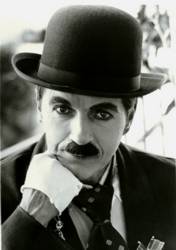
Charles Spencer Chaplin was born in London, England on April 16, 1889. His father was a versatile vocalist and actor; his mother, known by her stage name Lily Harley, was an actress and light opera singer. The early death of his father and his mother's ill-health left Charlie and his brother Sydney, virtually on their own. Charlie was less than 10 years old. Their familiarity with the stage naturally led them to performing as a way to earn money; Charlie Chaplin debuted as a member of the troupe called "The Eight Lancashire Lads" where he won popular acclaim for his performances. Charlie got his first chance to act in a legitimate stage show when he was about 14; he appeared as the page boy in "Sherlock Holmes" which starred William Gillette. At the close of the engagement, Charlie embarked on a career as a comedian in vaudeville which would take him to the United States as a featured player in the Fred Karno Repertoire Company. He was an immediate sensation especially in the more physical comedy sketches. When the Fred Karno troupe returned to the United States in the fall of 1912, Charlie Chaplin was offered a motion picture contract with Mack Sennett's Keystone Film Company which came into effect with the completion of his vaudeville commitments in November 1913. His starting salary was $150 a week. Charlie Chaplin was an overnight success prompting other producers to start negotiations for his services. When his Sennett contract was up, Chaplin moved on to the Essanay Company (1915) for a great deal more money. Sennett in the meantime, kept the Chaplin name on the marquee, hiring Charlie's brother Sydney Chaplin, newly arrived from England.
In 1916, Charlie Chaplin signed with the Mutual Film Corporation to make 12 2-reel comedies including "The Floorwalker", "The Fireman", "The Vagabond", "One A.M.", "The Count", "The Pawnshop", "Behind the Screen", "The Rink", "Easy Street", "The Cure", "The Immigrant" and "The Adventurer".
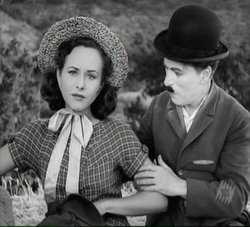
Charlie with Paulette Goddard in "Modern Times".
Chaplin began to yearn for the freedom to make the movies he wanted to make, the way he wanted to make them. When his contract with Mutual expired in 1917, Chaplin took on the role of independent producer; his first move was to begin the construction of his own studios at La Brea Avenue in the heart of Hollywood. Early in 1918, Charlie Chaplin entered into an agreement with First National Exhibitors' Circuit, a new organization specially formed to exploit his pictures. His first film under this new deal was "A Dog's Life". Soon after its release and with the start of World War I, Charlie Chaplin went on a national tour to promote the war effort; he made a film called "The Bond" for the US government, in support of the Liberty Loan drive. And in 1918 he produced a comedy dealing with the war. "Shoulder Arms" was a huge box office success making Chaplin more popular than ever. "Sunnyside" and "A Day's Pleasure" soon followed in 1919. 1919 was notable for other reasons as well; in that year, Charlie Chaplin joined with Mary Pickford, Douglas Fairbanks and D.W. Griffith to found the United Artists Corporation. It was a new concept for the film industry; until its founding, producers and distributors had been the employers. With the launch of United Artists, the stars became their own employers, receiving the producer profits as well as their fair share of the distribution profits. For the first time in the history of the young film industry, the stars were in control.
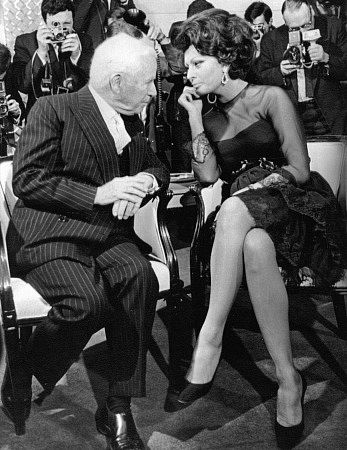
Charlie with Sophia Loren.
First however, Charlie had to complete his contract with First National which he did in 1921 with the release of a 6-reel masterpiece. In "The Kid", Chaplin introduced Jackie Coogan, one of the era's greatest child actors. Also released in 1921, "The Idle Class", in which he played two roles. Then, in September 1921, Chaplin sailed for Europe where he was given an enthusiastic reception wherever he went. When, after a long vacation, Chaplin returned to Hollywood, he began his active association with United Artists. Charlie Chaplin made eight feature-length pictures with United Artists: "A Woman of Paris" (1923) which he wrote, directed and produced, and appeared in a cameo role; "The Gold Rush" (1925); "The Circus" (1928); "City Lights" (1931); "Modern Times" (1936); "The Great Dictator" (1940), in which he played a dual role and talked on the screen for the first time; "Monsieur Verdoux" (1947) in which the public saw a new Chaplin, minus his traditional moustache, baggy trousers and wobbly cane; and "Limelight" (1952).
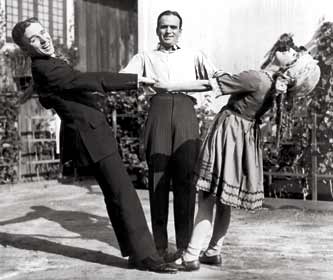
Charlie with Douglas Fairbanks and Mary Pickford.
In 1957, Charlie Chaplin released his comedy "A King in New York" which he wrote, acted in and directed, and for which he composed the music. In 1966, he produced his last picture, "A Countess from Hong Kong" for Universal Pictures, which starred Sophia Loren and Marlon Brando. As if a lifetime of writing, producing, acting and directing movies wasn't enough, Charlie Chaplin wrote at least four books, "My Trip Abroad", "A Comedian Sees the World", "My Autobiography", "My Life in Pictures". He was an accomplished self-taught musician, playing a number of instruments well including the violin and cello. And along with the music for all his films, Charlie composed a number of popular songs. In the end, Charlie Chaplin was the 20th century's renaissance man. Charlie Chaplin died on Christmas day 1977, survived by eight children from his last marriage with Oona O'Neill, and one son from his short marriage to Lita Grey.
Biography courtesy: Discover Chaplin.
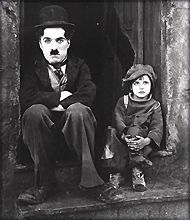
Charlie with Jackie Coogan in "The Kid".
Crystal's Favorite Charlie Chaplin Films:
The Kid (1921) - Tramp
Modern Times (1936) - A factory worker
City Lights (1931) - Tramp

Click on Charlie to go back.







